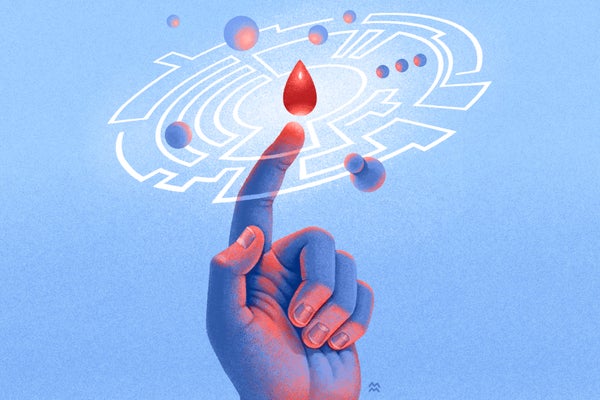October 14, 2025
2 min read
Type 1 Diabetes Science Is Having a Moment
Living with type 1 diabetes today is leaps and bounds easier than it was decades ago. Things are only getting better

This article is part of “Innovations In: Type 1 Diabetes,” an editorially independent special report that was produced with financial support from Vertex.
A little more than a century ago a diagnosis of type 1 diabetes was a death sentence. Today, thanks to extraordinary scientific progress, many people with type 1 diabetes—especially in developed countries—can enjoy long, healthy lives. I’m profoundly grateful that my older son, now 16, was born into this era of possibility. His diagnosis in 2020 came at a time when innovation and advocacy had transformed what it meant to live with this chronic autoimmune disease. I’m excited to share this Innovations In special report, in which we explore the remarkable advances reshaping the landscape of type 1 diabetes research and care.
Science journalist Carrie Arnold tells the stories of visionary entrepreneurs working toward an artificial pancreas—a closed-loop system that seamlessly integrates insulin pumps and glucose monitors to mimic the function of healthy beta cells. For many, this breakthrough feels like a cure.
On supporting science journalism
If you’re enjoying this article, consider supporting our award-winning journalism by subscribing. By purchasing a subscription you are helping to ensure the future of impactful stories about the discoveries and ideas shaping our world today.
Yet the pursuit of a true cure continues. Health journalist Tara Haelle delves into promising options, including beta cell transplants that would eliminate the need for immunosuppressive drugs. She also highlights the monoclonal antibody teplizumab, approved in 2022, which can delay the onset of symptomatic type 1 diabetes by five years or more in some people—a milestone in preventive medicine.
As the science races forward, the number of type 1 diabetes cases is surging. Statistical visualizations by data journalist Miriam Quick and senior graphics editor Jen Christiansen illustrate this troubling trend and expose the stark disparities in care. In wealthy nations such as the United Arab Emirates, a child diagnosed with type 1 diabetes may live nearly a full life. In contrast, a child in Niger could lose up to 50 years compared with the national average.
Associate editor Lauren J. Young introduces us to five exceptional individuals working to close these gaps—among them a radiology specialist who joined forces with fellow mothers to distribute insulin and establish education outreach across Venezuela, as well as clinicians trying to ease distress over diabetes and improve mental health. Their stories are deeply moving.
Health reporter Liz Szabo explores the strides in preventing or halting diabetic retinopathy, the leading cause of blindness in working-age adults. Science journalist Rachel Nuwer describes advances in genetic screening to identify kids at high risk of developing type 1 diabetes. That information could become life-altering as new treatments emerge.
Although managing type 1 diabetes will continue to be a 24/7 endeavor for now, I have realistic hope that a cure will emerge in my son’s lifetime.
It’s Time to Stand Up for Science
If you enjoyed this article, I’d like to ask for your support. Scientific American has served as an advocate for science and industry for 180 years, and right now may be the most critical moment in that two-century history.
I’ve been a Scientific American subscriber since I was 12 years old, and it helped shape the way I look at the world. SciAm always educates and delights me, and inspires a sense of awe for our vast, beautiful universe. I hope it does that for you, too.
If you subscribe to Scientific American, you help ensure that our coverage is centered on meaningful research and discovery; that we have the resources to report on the decisions that threaten labs across the U.S.; and that we support both budding and working scientists at a time when the value of science itself too often goes unrecognized.
In return, you get essential news, captivating podcasts, brilliant infographics, can’t-miss newsletters, must-watch videos, challenging games, and the science world’s best writing and reporting. You can even gift someone a subscription.
There has never been a more important time for us to stand up and show why science matters. I hope you’ll support us in that mission.









